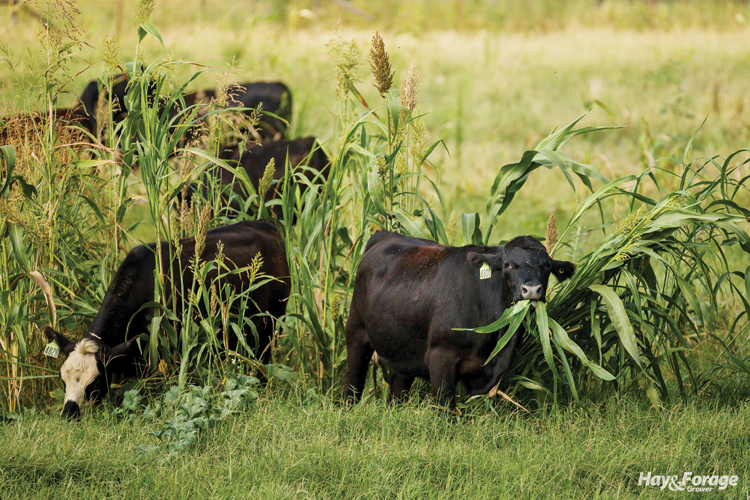
When margins are tight and time is money, ranchers look for ways to cut costs and boost their bottom line. If the economics of making and feeding hay on your livestock operation no longer make sense, consider leaving that forage on the stem and adding grazing days on your ranch.
Ranchers forgo the need for production equipment, storage facilities, and hours spent hunched in a tractor when they scale back their reliance on making and feeding hay. Instead, they find fringe benefits of better cattle nutrition, soil health, and — in the long term — improved carrying capacity by adaptively grazing, allowing adequate recovery, encouraging diversity, and, in some situations, adding seasonal cover crops.
Priority shift
Four years ago, Noble Research Institute’s Red River Ranch near Burneyville, Okla., was managed conventionally, and the ranch team, including ranch manager Kevin Pierce, spent their summers baling hay to feed cattle through the winter. In 2020, Pierce fed four to five bales of hay per cow each winter season. This past winter, he fed only one bale per cow.
Pierce now manages the ranch with soil health principles in mind, which encourage ranchers to consider the overall health of the land, livestock, and business for better sustainability. To this end, Pierce is more strategic about the intervals cattle are grazing the pastures, how long forage gets to rest, and pulling the cows off some fields well before winter to stockpile the grass.
Knowing how to manage cover crops and how to manage land to improve soil health and productivity are specialties of Jim Johnson, a senior regenerative ranching advisor at Noble.
“It comes back to how producers answer a few questions,” Johnson said. “When do I want to use it? When do I need to let it recover? When can I graze it prior to that?” He further explained that recovery periods depend more on weather and time than if the field is planted in warm-season, cool-season, or perennial forages.
Carrying capacity, cover crops
Johnson teaches ranchers the importance of first addressing stocking rate and carrying capacity when they think about pasture management and extending grazing days.
“Most producers who we’ve worked with are overstocked,” he said. “Getting your stocking right at or below carrying capacity is probably going to get you 90% of the way [to year-round grazing].”
Johnson has helped ranchers who participate in Noble’s educational courses evaluate pasture management options and consider the right time to destock, if necessary. He says now is a good time to sell off some cattle, given the market prices.
In addition to stockpiling forages, Pierce plants cool- and warm-season cover crops to use as standing forage in the winter and early spring. He plants a warm-season mix around June 1, grazes the field in early August, and then leaves it to rest until it’s needed as standing forage in December.
Johnson and Pierce agree there are many benefits to planting cover crops to be grazed in the winter, including the positive influence on soil health. It’s this priority — more so than improved nutrition for cattle and less investment of time and capital in making hay — that has influenced the management practices at Red River Ranch the most.
“A lot of places we plant these cover crops are old cropland fields,” Pierce explained. “A lot of them we farmed or mowed for hay for the last decade. Everything we grew was taken off; we never put anything back into the soil. Now, we’re trying to keep something growing out there year-round and to build organic matter back in the soil.”
Pierce has also experimented with letting these annual cover crops go to seed for volunteer regrowth the next season. He says grazing cattle in the pasture offers two-fold benefits: he gets an extra month or so of grazing and the cattle impact stimulates better regrowth.
“I feel I can get a better stand by coming back in with adaptive grazing and 50,000 pounds of stocking density moving across the pasture,” Pierce said. “The cows stomp the seed back into the ground and plant it.”
Farm values
Johnson believes there’s an economic benefit to additional grazing days, too.
“Economics would be a lot better, for one, because you’re not paying to cut, rake, bale, and haul it off, then haul it back and feed it to (the cattle),” Johnson said. “You don’t have the shrink from it decomposing in a field, or the capital expenditure if it’s in a barn for storage.”
Pierce also said he would much rather spend half of a day in his side-by-side setting up fencing and getting a good look at his herds than go back to his summers spent in the cab of a tractor.
This article appeared in the August/September 2024 issue of Hay & Forage Grower on page 29.
Not a subscriber?Click to get the print magazine.

